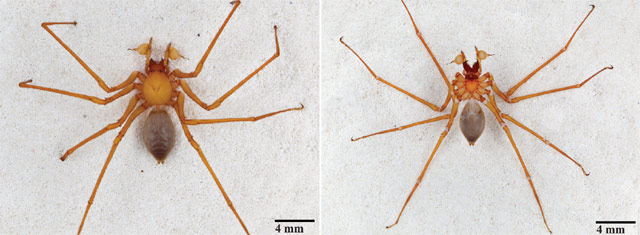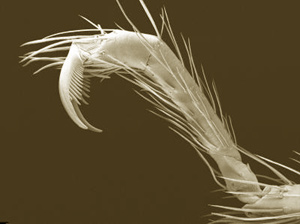A team of citizen scientists from the Western Cave Conservancy in Santa Cruz, California, and arachnologists from the California Academy of Sciences has found a new huge spider in caves of southwest Oregon.

A female Trogloraptor marchingtoni (Charles Griswold)
The forests of the coastal regions from California to British Columbia are renowned for their unique and ancient animals and plants, such as coast redwoods, tailed frogs, mountain beavers and the legendary Bigfoot.
Whereas Bigfoot is probably just fiction, the newly discovered spider Trogloraptor marchingtoni is very real.
Trogloraptor, or ‘cave robber,’ is named for its cave home and spectacular, elongate claws. It is a spider so evolutionarily special that it represents not only a new species and genus, but also a new family – the Trogloraptoridae.

Dorsal, left, and ventral view of a male Trogloraptor marchingtoni (Griswold et al / CC-BY 3.0)
Even for the species-rich insects and arachnids, to discover a new, previously unknown family is an historic moment.
A study, published in the journal Zookeys, discribes the new family and its evolutionary and conservation significance.
The team of citizen scientists and arachnologists discovered these spiders living in caves in southwest Oregon. Their colleagues from San Diego State University found more in old-growth redwood forests.
Dr Charles Griswold, Dr Joel Ledford, and Tracy Audisio, all at the California Academy of Sciences, collected, analyzed, and described the new family.

These are the remarkable, raptor-like claws of Trogloraptor (Griswold et al / CC-BY 3.0)
Trogloraptor hangs beneath rudimentary webs on cave ceilings. It is about four centimeters wide when its legs are extended – larger than the size of a half-dollar coin. Their extraordinary, raptorial claws suggest that they are fierce, specialized predators, but their prey and attack behavior remain unknown.
The anatomy of Trogloraptor forces arachnologists to revise their understanding of spider evolution.
Strong evidence suggests that Trogloraptor is a close relative of goblin spiders, but Trogloraptor possesses a mosaic of ancient, widespread features and evolutionary novelties.
The true distribution of Trogloraptor remains unknown: that such a relatively large, peculiar animal could elude discovery until 2012 suggests that more may be lurking in the forests and caves of western North America.
_______
Bibliographic information: Griswold et al. 2012. An extraordinary new family of spiders from caves in the Pacific Northwest (Araneae, Trogloraptoridae, new family). ZooKeys 215: 77-102; doi: 10.3897/zookeys.215.3547







